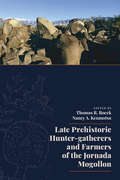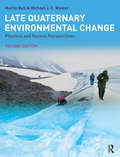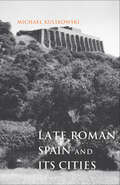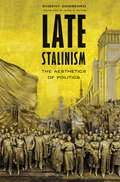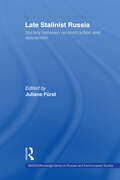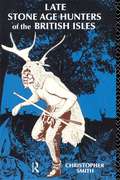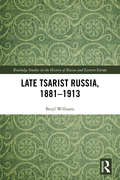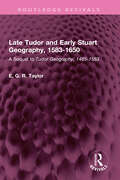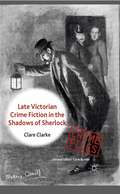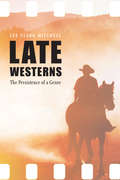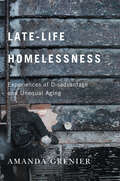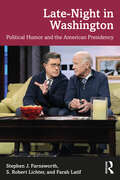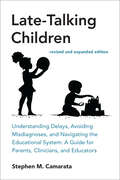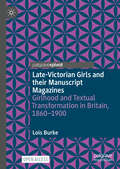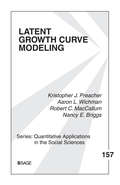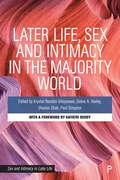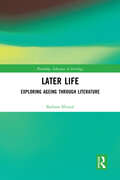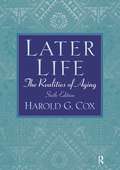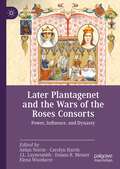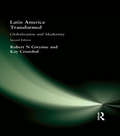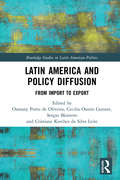- Table View
- List View
Late Prehistoric Hunter-Gatherers and Farmers of the Jornada Mogollon
by Thomas R. Rocek Nancy A. KenmotsuOften seen as geographically marginal and of limited research interest to archaeologists, the Jornada Mogollon region of the southwestern United States and northern Mexico deserves broader attention. Late Prehistoric Hunter-Gatherers and Farmers of the Jornada Mogollon presents the major issues being addressed in Jornada research and reveals the complex, dynamic nature of Jornada prehistory. The Jornada branch of the Mogollon culture and its inhabitants played a significant economic, political, and social role at multiple scales. This volume draws together results from recent large-scale CRM work that has amassed among the largest data sets in the Southwest with up-to-date chronological, architectural, faunal, ceramic, obsidian sourcing, and other specialized studies. Chapters by some of the most active researchers in the area address topics that reach beyond the American Southwest, such as mobility, forager adaptations, the transition to farming, responses to environmental challenges, and patterns of social interaction. Late Prehistoric Hunter-Gatherers and Farmers of the Jornada Mogollon is an up-to-date summary of the major developments in the region and their implications for Southwest archaeology in particular and anthropological archaeological research more generally. The publication of this book is supported in part by the Arizona Archaeological and Historical Society and the Center for Material Culture Studies at the University of Delaware. Contributors: Rafael Cruz Antillón, Douglas H. M. Boggess, Peter C. Condon, Linda Scott Cummings, Moira Ernst, Tim Graves, David V. Hill, Nancy A. Kenmotsu, Shaun M. Lynch, Arthur C. MacWilliams, Mary Malainey, Timothy D. Maxwell, Myles R. Miller, John Montgomery, Jim A. Railey, Thomas R. Rocek, Matt Swanson, Christopher A. Turnbow, Javier Vasquez, Regge N. Wiseman, Chad L. Yost
Late Quaternary Environmental Change: Physical and Human Perspectives
by Martin Bell M.J.C. WalkerLate Quaternary Environmental Change addresses the interaction between human agency and other environmental factors in the landscapes, particularly of the temperate zone.Taking an ecological approach, the authors cover the last 20,000 years during which the climate has shifted from arctic severity to the conditions of the present interglacial environment.
Late Roman Spain and Its Cities (Ancient Society and History)
by Michael KulikowskiThis groundbreaking history of Spain in late antiquity sheds new light on the fall of the western Roman empire and the emergence of medieval Europe.Historian Michael Kulikowski draws on the most recent archeological and literary evidence in this fresh an enlightening account of the Iberian Peninsula from A.D. 300 to 600. In so doing, he provides a definitive narrative that integrates late antique Spain into the broader history of the Roman empire. Kulikowski begins with a concise introduction to the early history of Roman Spain, and then turns to the Diocletianic reforms of 293 and their long-term implications for Roman administration and the political ambitions of post-Roman contenders. He goes on to examine the settlement of barbarian peoples in Spain, the end of Roman rule, and the imposition of Gothic power in the fifth and sixth centuries. In parallel to this narrative account, Kulikowski offers a wide-ranging thematic history, focusing on political power, Christianity, and urbanism.Kulikowski’s portrait of late Roman Spain offers some surprising conclusions, finding that the physical and social world of the Roman city continued well into the sixth century despite the decline of Roman power. Winner of an Honorable Mention in the Association of American Publishers’ Professional and Scholarly Publishing Awards in Classics and Archeology
Late Stalinism: The Aesthetics of Politics
by Evgeny DobrenkoHow the last years of Stalin&’s rule led to the formation ofan imperial Soviet consciousness In this nuanced historical analysis of late Stalinism organized chronologically around the main events of the period—beginning with Victory in May 1945 and concluding with the death of Stalin in March 1953—Evgeny Dobrenko analyzes key cultural texts to trace the emergence of an imperial Soviet consciousness that, he argues, still defines the political and cultural profile of modern Russia.
Late Stalinist Russia: Society Between Reconstruction and Reinvention (BASEES/Routledge Series on Russian and East European Studies)
by Juliane FürstThe late Stalinist period, long neglected by researchers more interested in the high-profile events of the 1930s, has recently become the focus of much new research by people keen to understand the enormous impact of the war on Soviet society and to understand Soviet life under 'mature socialism'. Written by top scholars from high profile universities, this impressive work brings together much new, cutting edge research on a wide range of aspects of late Stalinist society. Filling a gap in the literature, it focuses above all on the experience of the Soviet people and their interaction with ideology, state policy and national and international politics.
Late Star Trek: The Final Frontier in the Franchise Era (Mass Markets: Storyworlds Across Media)
by Adam KotskoHow Star Trek&’s twenty-first-century reinventions illuminate the unique challenges and opportunities of franchise-style corporate storytellingLate Star Trek explores the beloved science fiction franchise&’s repeated attempts to reinvent itself after the end of its 1990s golden age. Beginning with the prequel series Enterprise, Adam Kotsko analyzes the wealth of content set within Star Trek&’s sprawling continuity—including authorized books, the three &“Kelvin Timeline&” films, and the streaming series Discovery, Picard, Lower Decks, Prodigy, and Strange New Worlds—along with fan discourse, to reflect on the perils and promise of the franchise as a unique form of storytelling. Significantly including the licensed novels and comic books that fill out the Star Trek universe for its fans, Kotsko brings the multiple productions of the early twenty-first century together as a unified whole rather than analyzing them in their current stratified view. He argues that the variety of styles and approaches in this tumultuous era of Star Trek history provides the perfect opportunity to reflect on the nature of the franchise storyworlds that now dominate popular culture. By taking the spin-offs and tie-ins seriously as creative attempts to tell a new story within an established universe, Late Star Trek highlights creative triumphs as well as the tendency for franchise faithfulness to get in the way of creating engaging characters and ideas. Arguing forcefully against the prevailing consensus that franchises are a sign of cultural decay, Kotsko contends that the Star Trek universe exemplifies an approach to storytelling that has been perennial across cultures. Instead, he finds that what limits creativity within franchises is not their reliance on the familiar but their status as modern myths, held not as common cultural heritage but rather owned as corporate intellectual property. Retail e-book files for this title are screen-reader friendly with images accompanied by short alt text and/or extended descriptions.
Late Stone Age Hunters of the British Isles
by Christopher SmithFor 7,000 years after the last ice age, the people of the British Isles subsisted by hunting wild game and gathering fruits of the forest and foreshore. Belonging to the late Upper Palaelithic and Mesolithic periods, these hunter-gatherers have hitherto been viewed mainly in terms of stone tool typologies. late Stone Age Hunters of the British Isles departs from this conventional approach, reassessing the archaeological evidence and placing it within a wider ecological and geographical context. This well illustrated study, which includes case studies, maps and photographs, provides a balanced approach to the study of a period that demands multi-disciplinary treatment. It outlines a range of considerations that have a bearing on the study of early societies in the British Isles, and also forms a useful guide to communiites themselves as represented by known archaeological sites.
Late Tsarist Russia, 1881–1913 (Routledge Studies in the History of Russia and Eastern Europe)
by Beryl WilliamsThis book brings together the large volume of work on late Tsarist Russia published over the last 30 years, to show an overall picture of Russia under the last two tsars - before the war brought down not only the Russian empire but also those of Germany, Austria–Hungary and Turkey. It turns the attention from the old emphases on workers, revolutionaries, and a reactionary government, to a more diverse and nuanced picture of a country which was both a major European great power, facing the challenges of modernization and industrialization, and also a multi-ethnic and multi-confessional empire stretching across both Europe and Asia.
Late Tudor and Early Stuart Geography, 1583-1650: A Sequel to Tudor Geography, 1485-1583 (Routledge Revivals)
by E. G. TaylorFirst published in 1934, Late Tudor and Early Stuart Geography is a critical commentary on a chronologically arranged bibliography of nearly two thousand contemporary printed and manuscript works. Poets, preachers and philosophers, mathematicians, physicians and astrologers, sailors, merchants and company-promoters were contributors to the absorbing medley that comprises the geographical literature of the late Tudor and early Stuart period. For this was the fading twilight of that Golden Age of unspecialized learning when all knowledge lay within one man’s compass. This book will be of interest to historians, economists, sociologists and litterateurs.
Late Victorian Crime Fiction in the Shadows of Sherlock (Crime Files)
by C. ClarkeThis book investigates the development of crime fiction in the 1880s and 1890s, challenging studies of late-Victorian crime fiction which have given undue prominence to a handful of key figures and have offered an over-simplified analytical framework, thereby overlooking the generic, moral, and formal complexities of the nascent genre.
Late Westerns: The Persistence of a Genre (Postwestern Horizons)
by Lee Clark MitchellFor more than a century the cinematic Western has been America’s most familiar genre, always teetering on the verge of exhaustion and yet regularly revived in new forms. Why does this outmoded vehicle—with the most narrowly based historical setting of any popular genre—maintain its appeal? In Late Westerns Lee Clark Mitchell takes a position against those critics looking to attach “post” to the all-too-familiar genre. For though the frontier disappeared long ago, though men on horseback have become commonplace, and though films of all sorts have always, necessarily, defied generic patterns, the Western continues to enthrall audiences. It does so by engaging narrative expectations stamped on our collective consciousness so firmly as to integrate materials that might not seem obviously “Western” at all. Through plot cues, narrative reminders, and even cinematic frameworks, recent films shape interpretive understanding by triggering a long-standing familiarity audiences have with the genre. Mitchell’s critical analysis reveals how these films engage a thematic and cinematic border-crossing in which their formal innovations and odd plots succeed deconstructively, encouraging by allusion, implication, and citation the evocation of generic meaning from ingredients that otherwise might be interpreted quite differently. Applying genre theory with close cinematic readings, Mitchell posits that the Western has essentially been “post” all along.
Late-Life Homelessness: Experiences of Disadvantage and Unequal Aging
by Amanda GrenierAround the world and across a range of contexts, homelessness among older people is on the rise. In spite of growing media attention and new academic research on the issue, older people often remain unrecognized as a subpopulation in public policy, programs, and homeless strategies. As such, they occupy a paradoxical position of being hypervisible while remaining overlooked.Late-Life Homelessness is the first Canadian book to address this often neglected issue. Basing her analysis on a four-year ethnographic study of late-life homelessness in Montreal, Canada, Amanda Grenier uses a critical gerontological perspective to explore life at the intersection of aging and homelessness. She draws attention to disadvantage over time and how the condition of being unhoused disrupts a person’s ability to age in place, resulting in experiences of unequal aging. Weaving together findings from policy documents, stakeholder insights, and observations and interviews with older people, this book demonstrates how structures, organizational practices, and relationships related to homelessness and aging come to shape late life.Situated in the context of an aging population, rising inequality, and declining social commitments, Late-Life Homelessness stresses the moral imperative of responding justly to the needs of older people as a means of mitigating the unequal aging of unhoused elders.
Late-Night in Washington: Political Humor and the American Presidency
by S. Robert Lichter Stephen J. Farnsworth Farah LatifThis book traces the trajectory of late-night political humor, which has long been a staple of entertainment television and is now a prominent part of social media political discourse, especially when it comes to the presidency. From Richard Nixon on Laugh-In to Donald Trump’s avatar on Saturday Night Live, this book takes the next step and considers how late-night comedy treats Joe Biden, the new American president who strives to restore a civil public tone but offers far less comedy fodder than his predecessor. Employing content analysis, public opinion surveys, and a variety of other quantitative and qualitative research, the authors look beyond the day-to-day memes and mimes of late-night comics and show how political humor may evolve. For students and scholars of politics and the media, this book will appeal to the general public and political pundits as well.
Late-Night in Washington: Political Humor and the American Presidency
by S. Robert Lichter Stephen J. Farnsworth Farah LatifThis book traces the trajectory of late-night political humor, which has long been a staple of entertainment television and is now a prominent part of social media political discourse, especially when it comes to the presidency. From Richard Nixon on Laugh-In to Donald Trump’s avatar on Saturday Night Live, this book takes the next step and considers how late-night comedy treats Joe Biden, the new American president who strives to restore a civil public tone but offers far less comedy fodder than his predecessor. Employing content analysis, public opinion surveys, and a variety of other quantitative and qualitative research, the authors look beyond the day-to-day memes and mimes of late-night comics and show how political humor may evolve. For students and scholars of politics and the media, this book will appeal to the general public and political pundits as well.
Late-Talking Children, revised and expanded edition: Understanding Delays, Avoiding Misdiagnoses, and Navigating the Educational System: A Guide for Parents, Clinicians, and Educators
by Stephen M. CamarataA revised and expanded edition of the bestselling guide to late-talking children for parents, clinicians, and educators, from a leading authority on development and disabilities.Every year in America, more than half a million parents of late-talking children face agonizing questions: What should I do if my two- or even three-year-old has not yet begun to talk? Should I worry that my child is autistic or intellectually disabled? Are expensive therapies or medications needed? Will my child ever speak normally? In this revised and expanded edition of the essential resource on the subject, Late-Talking Children, Stephen Camarata—the parent of a late-talking child and a late talker himself—provides clear, sensible, and compassionate answers for parents, clinicians, and educators, drawing on his more than three decades of experience diagnosing and treating the &“late-talking syndrome&” as well as the best science available today.
Late-Victorian Girls and their Manuscript Magazines: Girlhood and Textual Transformation in Britain, 1860-1900
by Lois BurkeThis open access book presents fresh archival evidence to explore the underexamined manuscript cultures of girls living in Britain in the late nineteenth century. Girls were keen writers during this period, which witnessed Golden Ages of children's literature and journalism, as well as major developments in proto feminism. Girl writers were particularly prolific in the writing of manuscript magazines. These were handmade magazines in which the contributors were also the readers and subscribers. This book presents three case study chapters exploring manuscript magazines which were created and exchanged amongst girl-led writing groups and within families, and references many other examples of manuscript magazine cultures from the late-Victorian period. It argues that strategies of transformative writing—namely appropriating literary texts—often characterized girls' contributions to manuscript magazines.
Lateinamerikaberichterstattung der deutschen Presse: Struktur und Entstehungsbedingungen
by Regina CazzamattaDas vorliegende Buch zu Struktur und Entstehungsbedingung Lateinamerikas in der deutschen Presse basiert auf einer in dieser Dimension bis heute nicht vorhandenen empirischen Grundlage. Die Studie basiert auf 21.929 Beiträgen, von denen mithilfe einer geschichteten Stichprobe 4.164 in die Analyse einbezogen, ausgewertet und mit Korrespondenten-Interviews kombiniert wurden. Sie beleuchtet die Auswahlkriterien und Mechanismen der Berichterstattung zu Lateinamerika und füllte eine Forschungslücke zu einem Thema, das außenpolitisch extrem relevant ist. Das Buch betrachtet Themen und Merkmale des Mediendiskurses in kombinierter Form, stellt Länderprofile dar und sucht nach theoretischen Erklärungen für die Bildkonstruktionen. Die Studie kommt zum Ergebnis, dass es das Lateinamerikabild in der deutschen Presse nicht gibt, sondern sich eine Perzeption nach Ländern und Landesgruppen ausdifferenziert lässt. Die Forschungsarbeit ist über das Fachgebiet Medien- und Kommunikationswissenschaft hinaus interessant und bedeutet einen Gewinn für die Lateinamerikaforschung in Deutschland.
Latent Growth Curve Modeling (Quantitative Applications in the Social Sciences #157)
by Kristopher J. Preacher Aaron Lee Wichman Dr Nancy E. Briggs Robert Charles MacCallumLatent growth curve modeling (LGM)—a special case of confirmatory factor analysis designed to model change over time—is an indispensable and increasingly ubiquitous approach for modeling longitudinal data. This volume introduces LGM techniques to researchers, provides easy-to-follow, didactic examples of several common growth modeling approaches, and highlights recent advancements regarding the treatment of missing data, parameter estimation, and model fit. The book covers the basic linear LGM, and builds from there to describe more complex functional forms (e.g., polynomial latent curves), multivariate latent growth curves used to model simultaneous change in multiple variables, the inclusion of time-varying covariates, predictors of aspects of change, cohort-sequential designs, and multiple-group models. The authors also highlight approaches to dealing with missing data, different estimation methods, and incorporate discussion of model evaluation and comparison within the context of LGM. The models demonstrate how they may be applied to longitudinal data derived from the NICHD Study of Early Child Care and Youth Development (SECCYD).. Key Features· Provides easy-to-follow, didactic examples of several common growth modeling approaches · Highlights recent advancements regarding the treatment of missing data, parameter estimation, and model fit · Explains the commonalities and differences between latent growth model and multilevel modeling of repeated measures data · Covers the basic linear latent growth model, and builds from there to describe more complex functional forms such as polynomial latent curves, multivariate latent growth curves, time-varying covariates, predictors of aspects of change, cohort-sequential designs, and multiple-group models.
Later Life, Sex and Intimacy in the Majority World (Sex and Intimacy in Later Life)
by Barry Lee Nafhesa Ali Sheren El Feki Selma Hajri Anushkaa Arora Sally Anne Param Travis Kong Madeline Burns Marcus Kissoon Cuauhtemoc SanchezLiterature on sex, intimacy and sexuality in later life has been heavily influenced by perspectives from more affluent regions, perpetuating the belief that the West is more sexually progressive and liberal than other cultures.This book challenges this belief by exploring diverse cultures and perspectives from the majority world, which are often overlooked. It highlights the importance of learning from cultures in the global South and East, dismantling stereotypes that frame them as sexually conservative or inferior. Variously drawing on structuralist, postcolonial and decolonial theory as well as social anthropology, the book critically examines binaries related to culture, age, sex and intimacy, highlighting the need to decentre Western perspectives as the benchmark while other cultures and practices are misunderstood.
Later Life: Exploring Ageing through Literature (Routledge Advances in Sociology)
by Barbara A. MisztalLater Life views older age as a valuable stage of life and argues for the centrality of self-making to the quality of later life. Aiming to enrich an understanding of ageing as the unfolding process in which people try to negotiate vulnerabilities of their bodies and manage mortality, it explores the conditions for pursuing the search for knowledge of oneself in later life. This new book, with the help of literary examples, presents factors both supporting and hindering the quality of the experience of later life. It demonstrates how wondering, courage and habit sustain the self-making in older age. After illustrating that the process of ageing also imposes ordeals, the book depicts remedies needed to overcome boredom, bitterness and sadness, three torments caused by the age-specific sense of time. It is essential reading not only for academics and professionals in age studies, sociology of ageing, gerontology and health care, but also for a general audience. The book’s focus on the experiences of later life will appeal to the reader interested in understanding the complexities of ageing and in enhancing the quality of later life, while its reliance on literary illustrations will be appreciated by lovers of literature.
Later Life: The Realities of Aging
by Harold G. CoxAn interdisciplinary introduction to the aging process which uses symbolic interactionism as the main theoretical perspective. Accessible, interdisciplinary coverage with chapters covering a variety of subject matter areas from biology to psychology, from economics to sociology, from political science to religion. Utilizes symbolic interaction perspective to explain behavior problems and an individual's adaptations associated with the process of aging.
Later Plantagenet and the Wars of the Roses Consorts: Power, Influence, and Dynasty (Queenship and Power)
by Elena Woodacre Carolyn Harris J. L. Laynesmith Aidan Norrie Danna R. MesserThis book examines the lives and tenures of the consorts of the Plantagenet dynasty during the later Middle Ages, encompassing two major conflicts—the Hundred Years’ War and the Wars of the Roses. The figures in this volume include well-known consorts such as the “She Wolves” Isabella of France and Margaret of Anjou, as well as queens who are often overlooked, such as Philippa of Hainault and Joan of Navarre. These innovative and authoritative biographies bring a fresh approach to the consorts of this period—challenging negative perceptions created by complex political circumstances and the narrow expectations of later writers, and demonstrating the breadth of possibilities in later medieval queenship. Their conclusions shed fresh light on both the politics of the day and the wider position of women in this age. This volume and its companions reveal the changing nature of English consortship from the Norman Conquest to today.
Latin America Transformed: Globalization and Modernity
by Robert N Gwynne Kay CristobalPraise for the first edition:'Accomplishes its task to provide readers with a broad multi-disciplinary view on globalization's many impacts on Latin America ... the organization of the collection is logical and thoughtful, and the structural perspectives offered are convincing and powerful. I recommend it to other Latin American social scientists.' Growth and Change 'An impressive, timely and lively volume, which is especially valuable for teaching purposes.' Journal of Latin American Studies'Authoritatively written by leading scholars in their respective fields.' AreaLatin America Transformed, 2nd Edition explains the region's economic, political, social and cultural transformations, its association with globalization and the search for modernity, and contributes to a greater understanding of how these transformations are affecting the people of Latin America.Using a political economy approach to unravel the concepts of globalization and modernity within Latin America, emphasis is placed on interpreting the macro-level structures that frame the transformations taking place. The book also investigates the dynamics of people's livelihoods as they make sense of, rework and live out these structural transformations. The international team of authors involved with the successful first edition have updated their focus and substantially rewritten their material to examine the challenges facing Latin America in the twenty-first century. Three completely new chapters have also been added. Latin America Transformed, 2nd Edition is now even more useful for undergraduate and postgraduate courses that examine economic, political, social and cultural change in Latin America.
Latin America and Contemporary Modernity: A Sociological Interpretation (Routledge Advances in Sociology)
by José Maurício DominguesIn this book, renowned author José Maurício Domingues places Latin America within the third phase of global modern civilization and offers a general theoretical approach to contemporary Latin America. He sees modernity as configured by episodic modernizing moves which, when counting on strong identity and organization as well as clear-cut projects, may assume the aspect of modernizing offensives. Highlighting subjects as law, rights and justice as well as globalization and development, Dominguez places Latin America in the uneven, combined and contradictory development of modern civilization and offers a final assessment of its possibilities and limits. The book will be of interest to researchers and students of modernity, globalization, Latin America, sociological theory and its key concepts.
Latin America and Policy Diffusion: From Import to Export (Routledge Studies in Latin American Politics)
by Osmany Porto de Oliveira Sergio Montero Cecilia Osorio Gonnet Cristiane Kerches da Silva LeiteLatin American countries have for a long time been importers of public policies and institutions from the Global North. The colonial legacy and resulting patterns of international relations during the 20th century favoured a course of adoption and hybridization of political institutions. In recent decades, a new conjuncture has emerged in which Latin American policies have started to diffuse South-South and even South-North. Led by Brazil with Participatory Budgeting and the Bolsa Familia program, other countries in the region soon followed. The Bus Rapid Transit (BRT) system and bicycle policies in Curitiba and Bogotá have also reached wide international recognition and circulation. And yet, despite Latin America’s new role as a policy "exporter", little is known about its dynamics, causes, and effects. Why have Latin American policies been diffused inside and outside the region? Which actors are involved? What driving forces affect these processes? This innovative collection offers a new perspective on the policy diffusion phenomena. Drawing on different examples from Latin American experiences in urban local policies and national social policies, experts present a new framework to study this phenomenon centered on the mobilization of ideas, interests and discourses for policy diffusion. Latin America and Policy Diffusion will be of great interest to researchers, educators, advanced students and practitioners working in the fields of political science, public policy, international relations and Latin American Studies.
